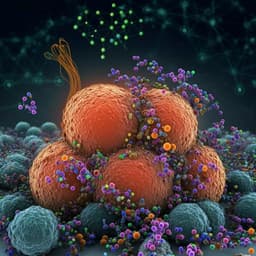
Physics
Absolute excited state molecular geometries revealed by resonance Raman signals
G. Batignani, E. Mai, et al.
Discover groundbreaking insights into excited-state potential energy surfaces and their role in ultrafast light-activated reactions. This innovative two-color broadband impulsive Raman experimental scheme, led by Giovanni Batignani and colleagues, reveals the direction and magnitude of excited-state displacements, providing a new understanding of stimulated vibrational coherences.
Playback language: English
Introduction
Photochemical and photophysical reactions are fundamentally determined by excited-state (ES) potential energy surfaces (PESs). These PESs dictate nuclear motions, initiating molecular rearrangements along specific vibrational degrees of freedom. Upon photoexcitation, nuclei shift their equilibrium positions, causing geometrical changes that alter the system's physical and chemical properties. Nature expertly tailors electronically excited PESs to efficiently convert absorbed light energy into molecular rearrangements, driving biological functions and photochemistry through bond length modifications, torsional reorientations, and bond formation/rupture. These processes can be understood through the multidimensional displacement vector (D) between PESs – the vector pointing to the new ES equilibrium position projected onto the ground state (GS) eigenvectors (Q). The magnitude of displacement components (d = D·Q) indicates the vibrational modes most involved in the excitation and their coupling to the ES. Critically, the direction of D determines whether equilibrium bond distances and angles bring functional groups closer or farther apart, profoundly impacting ES physical-chemical properties. Examples include stilbene photoisomerization (C=C bond length increase), rhodopsin isomerization (dihedral angle changes), and diaryl thiophenes (interatomic distance changes). The ability to measure excited state displacements is essential for validating quantum chemistry models for nonlinear optical effects. However, conventional methods like absorption spectroscopy struggle to determine the direction of these displacements, as opposite directions can yield similar spectral signatures.
Literature Review
Spontaneous Raman spectroscopy is a powerful tool for studying GS vibrational spectra. Resonant Raman (RR) spectroscopy, achieved by tuning the excitation wavelength to match an electronic transition energy, results in a cross-section proportional to the square modulus of the product of electronic transition moments and GS-ES vibrational overlaps, providing information related to relative PES geometries. This intrinsically limits RR sensitivity to the absolute values of ES displacements. The missing sign information hinders understanding molecular reorientations crucial to photophysical and photochemical phenomena. Furthermore, obtaining consistent RR responses across multiple narrowband experiments is challenging due to fluorescence. Nonlinear time-domain Raman schemes, like impulsive stimulated Raman scattering (ISRS), offer advantages. ISRS uses temporally separated pulses to investigate vibrational properties: a Raman pump generates vibrational coherences, and a broadband probe pulse measures the modulated sample transmissivity. This provides amplitude and phase information of vibrational oscillations, and heterodyne detection efficiently suppresses fluorescence. The time-domain acquisition avoids nonlinear artifacts.
Methodology
This work introduces a two-color broadband ISRS scheme to determine the real and imaginary parts of the nonlinear RR susceptibility, revealing absolute ES geometries. The time-domain signal is analyzed before Fourier transformation to preserve phase information. An off-resonant pump induces vibrational coherences on the GS, while a resonant probe pulse targets a specific electronic transition. This approach ensures the ISRS signal is proportional to the amplitude of GS-ES Franck-Condon overlap integrals, not their squared modulus, making it sensitive to the sign of PES displacements. For a diatomic molecule, ES geometries with increased or decreased nuclear bond length have FC overlaps with equal magnitude and opposite sign. The two-color ISRS signal is antisymmetric with respect to the GS-to-ES atomic distance modification, directly revealing ES displacement. The sign of ES displacements relative to GS eigenvectors is defined, uniquely identifying the ES equilibrium configuration along a given vibrational mode. The broadband ISRS response is evaluated semiclassically through a perturbative expansion of the molecular density matrix, considering two classes (A/B) of Feynman diagrams. The spectrally dispersed ISRS signal S(ω, ΔT) is expressed as the imaginary part of the ratio between the total third-order polarization and the probe field spectral envelope. Both A and B diagrams contain sum-over-states expressions and are sensitive to ES geometry. For an off-resonant pump, the radiation-matter interaction Hamiltonian prepares vibrational coherences. The complex Raman excitation profiles are expressed mathematically, reflecting the sensitivity of the method to ES geometry. The odd symmetry of the complex Raman excitation profiles with respect to displacement allows identification of the sign of the displacement. To access the real and imaginary parts of the REPs, probe chirp is tuned. Specific chirp values and temporal delays allow separate measurement of real and imaginary components of the Stokes/anti-Stokes REPs. The methodology for reconstruction of complex REPs from impulsive Raman experiments is explained thoroughly. Time-dependent (TD) density functional theory (DFT) calculations are used to model the Raman excitation profiles and extract displacement values.
Key Findings
The two-color broadband ISRS scheme was applied to Rhodamine B (RhB) in methanol. Time-domain traces were recorded for various probe wavelengths and chirps. Fourier transformation yielded frequency-domain spectra, identifying key Raman bands. ISRS traces were fit to a sum of sinusoidal terms to extract amplitudes and phases for individual modes. The chirped probe pulse allows for the real and imaginary parts of the Stokes and anti-Stokes Raman excitation profiles to be extracted, and subsequently, the magnitude and the sign of the displacements of the excited state normal modes. The experimental and theoretical signals showed good agreement. A detailed analysis of the chirp dependence of the ISRS response demonstrated the ability to isolate the real and imaginary components of the complex REPs. Specifically for the 735 cm⁻¹ mode, the real and imaginary parts of the REP were successfully extracted using specific chirp values. The experimental and theoretically computed results exhibit the same sign for all modes, confirming the accuracy of the approach. Minor discrepancies are attributed to factors like probe spectral profile, sample absorption, third-order dispersion, and potential deviation between calculated and actual ES displacements. The absorption spectrum was compared with theoretical predictions based on TD-DFT displacements, revealing a need to scale low- and high-frequency mode displacements to accurately reproduce the experimental spectrum. The relative magnitudes of displacements are extracted from ISRS oscillation intensities. Absolute amplitudes are obtained from broadband ISRS detection, which allows for detailed mapping of the REPs. The complex resonant Raman excitation profiles for five normal modes were extracted and analyzed. The results indicate that an increase of the distance between the oxygen and the distal carbon in the RhB central pyran ring in the excited state, which leads to the elongation of this ring. The oxygen atom's movement drives an out-of-plane carboxylic acid rotation, and benzene ring carbon atom rearrangement leads to their expansion. The complete determination of the complex REPs is enabled by only a few probe chirps and time delays, resulting in rapid acquisition and high signal-to-noise ratio.
Discussion
This study successfully demonstrates a method to obtain the complete characterization of the excited state potential energy surfaces, and specifically the magnitude and sign of the excited state displacements for Rhodamine B. The agreement between experimental and theoretical results validates the approach, emphasizing the importance of considering both the real and imaginary parts of the complex Raman excitation profiles. The method allows for detailed mapping of reaction coordinates and an understanding of the initial stages of relaxation dynamics for photoactive compounds. The ability to determine the direction of excited state displacements has implications for understanding various photochemical and photophysical phenomena and provides an important tool for validating and improving theoretical models of excited state dynamics.
Conclusion
This research presents a novel two-color broadband impulsive stimulated Raman scattering (ISRS) technique for accurately determining the magnitude and sign of excited state displacements in molecules. The method successfully maps the excited state potential energy surface of Rhodamine B, revealing detailed molecular rearrangements. Future applications of this technique could significantly advance understanding of photo-induced dynamics and reaction mechanisms in various systems.
Limitations
While the study provides a significant advancement in determining ES geometries, limitations exist. Discrepancies between experimental and theoretical results point to the influence of factors such as the probe spectral profile, sample absorption, third-order dispersion, and potential inaccuracies in TD-DFT calculations of molecular displacements. Further refinement of the theoretical model, incorporating these effects, is needed for even more precise determination of ES geometries. The analysis focuses on a specific molecule, and further studies are necessary to establish the method's applicability to a wider range of systems.
Related Publications
Explore these studies to deepen your understanding of the subject.







